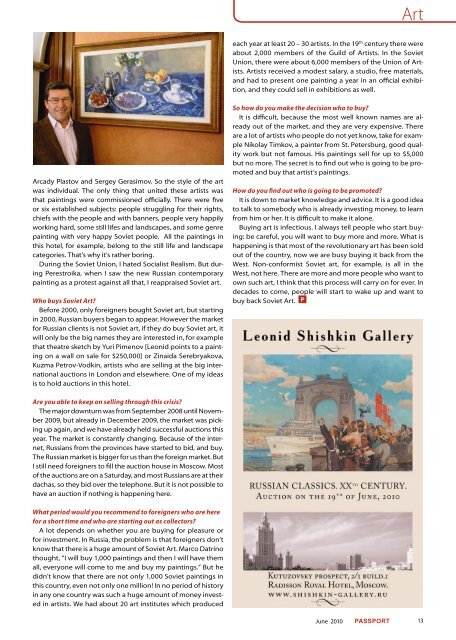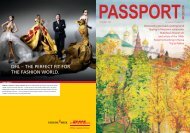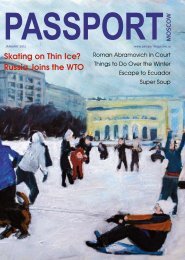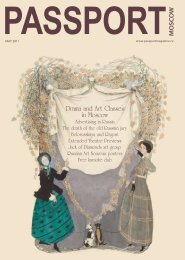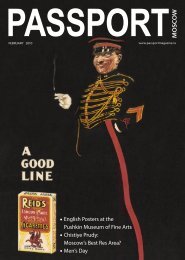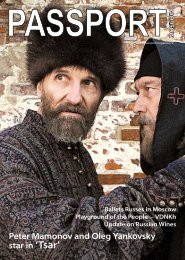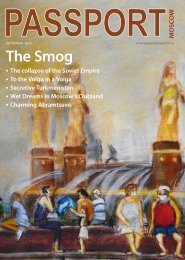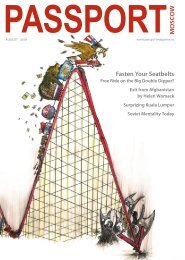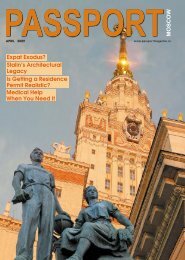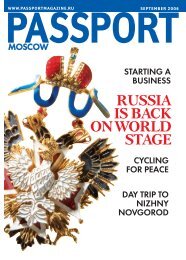M O S C O W Interview with Leonid Shishkin - Passport magazine
M O S C O W Interview with Leonid Shishkin - Passport magazine
M O S C O W Interview with Leonid Shishkin - Passport magazine
Create successful ePaper yourself
Turn your PDF publications into a flip-book with our unique Google optimized e-Paper software.
Arcady Plastov and Sergey Gerasimov. So the style of the art<br />
was individual. The only thing that united these artists was<br />
that paintings were commissioned officially. There were five<br />
or six established subjects: people struggling for their rights,<br />
chiefs <strong>with</strong> the people and <strong>with</strong> banners, people very happily<br />
working hard, some still lifes and landscapes, and some genre<br />
painting <strong>with</strong> very happy Soviet people. All the paintings in<br />
this hotel, for example, belong to the still life and landscape<br />
categories. That’s why it’s rather boring.<br />
During the Soviet Union, I hated Socialist Realism. But during<br />
Perestroika, when I saw the new Russian contemporary<br />
painting as a protest against all that, I reappraised Soviet art.<br />
Who buys Soviet Art?<br />
Before 2000, only foreigners bought Soviet art, but starting<br />
in 2000, Russian buyers began to appear. However the market<br />
for Russian clients is not Soviet art, if they do buy Soviet art, it<br />
will only be the big names they are interested in, for example<br />
that theatre sketch by Yuri Pimenov [<strong>Leonid</strong> points to a painting<br />
on a wall on sale for $250,000] or Zinaida Serebryakova,<br />
Kuzma Petrov-Vodkin, artists who are selling at the big international<br />
auctions in London and elsewhere. One of my ideas<br />
is to hold auctions in this hotel.<br />
Are you able to keep on selling through this crisis?<br />
The major downturn was from September 2008 until November<br />
2009, but already in December 2009, the market was picking<br />
up again, and we have already held successful auctions this<br />
year. The market is constantly changing. Because of the internet,<br />
Russians from the provinces have started to bid, and buy.<br />
The Russian market is bigger for us than the foreign market. But<br />
I still need foreigners to fill the auction house in Moscow. Most<br />
of the auctions are on a Saturday, and most Russians are at their<br />
dachas, so they bid over the telephone. But it is not possible to<br />
have an auction if nothing is happening here.<br />
What period would you recommend to foreigners who are here<br />
for a short time and who are starting out as collectors?<br />
A lot depends on whether you are buying for pleasure or<br />
for investment. In Russia, the problem is that foreigners don’t<br />
know that there is a huge amount of Soviet Art. Marco Datrino<br />
thought, “I will buy 1,000 paintings and then I will have them<br />
all, everyone will come to me and buy my paintings.” But he<br />
didn’t know that there are not only 1,000 Soviet paintings in<br />
this country, even not only one million! In no period of history<br />
in any one country was such a huge amount of money invested<br />
in artists. We had about 20 art institutes which produced<br />
June 2010<br />
Art<br />
each year at least 20 – 30 artists. In the 19 th century there were<br />
about 2,000 members of the Guild of Artists. In the Soviet<br />
Union, there were about 6,000 members of the Union of Artists.<br />
Artists received a modest salary, a studio, free materials,<br />
and had to present one painting a year in an official exhibition,<br />
and they could sell in exhibitions as well.<br />
So how do you make the decision who to buy?<br />
It is difficult, because the most well known names are already<br />
out of the market, and they are very expensive. There<br />
are a lot of artists who people do not yet know, take for example<br />
Nikolay Timkov, a painter from St. Petersburg, good quality<br />
work but not famous. His paintings sell for up to $5,000<br />
but no more. The secret is to find out who is going to be promoted<br />
and buy that artist’s paintings.<br />
How do you find out who is going to be promoted?<br />
It is down to market knowledge and advice. It is a good idea<br />
to talk to somebody who is already investing money, to learn<br />
from him or her. It is difficult to make it alone.<br />
Buying art is infectious. I always tell people who start buying:<br />
be careful, you will want to buy more and more. What is<br />
happening is that most of the revolutionary art has been sold<br />
out of the country, now we are busy buying it back from the<br />
West. Non-conformist Soviet art, for example, is all in the<br />
West, not here. There are more and more people who want to<br />
own such art, I think that this process will carry on for ever. In<br />
decades to come, people will start to wake up and want to<br />
buy back Soviet Art. P<br />
1


